Hyatt – or do programs think globally?

23 November 2016
The upcoming relaunch of Hyatt’s loyalty program has been welcomed overwhelmingly positively. But it raises the interesting question of how global loyalty program strategies can and should be.
You take any Frequent Flyer Program and they would typically have 60-80% of their members based in their home market. As a result, most efforts are put into these customers, but also thinking of management centers around these customers. Which obviously leads to the chicken-egg question whether membership structure is local because of what the program has to offer or whether management focuses on the local market because of the program’s membership structure. Sometimes we like to challenge program managers by asking whether the second option in not simply a comfort zone for program managers they like to subscribe to because of that comfort factor. It is definitely easier to conclude a deal with the airport hotel next to your office than implementing international hotel partners. How relevant that airport hotel is though to local residents is another question…
By nature, international hotel chains should have a much more natural global spirit since their membership base is split more evenly across the globe. And they do not only cater for customers with some ties to their home country, but one can perfectly be a purely domestic traveller in Italy with no intention to go ever to the US and be a loyal member of Best Western, thanks to their coverage in the country. Theoretically, you could also be a Delta member living in Italy and flying only domestically on SkyTeam partner Alitalia, but this is nevertheless less likely to happen since the Delta program doesn’t target such customers and doesn’t offer them anything beyond the airline network, as a local program would typically do.
Nevertheless, even hotel chains are dominated by a central management team. Looking at the largest hotel chains, this means we talk mostly about US management teams, one French one and maybe a Chinese one in a near future. Leaving the particular case of China aside – a Chinese hotel chain can perfectly succeed by targeting strategically Chinese travellers only -, all the others can’t afford such a strategy and need to target international customers.
Even taking a chain like Hyatt – still big, but not as large as the real big ones -, they are proudly represented in more than 50 countries with all the resulting challenges upon the loyalty management team. Combine this with the issue of having to manage different brands within the portfolio – often from budget to luxury – and you get the challenging picture. While this would not necessarily apply to an upscale brand like Hyatt, other hotel chains even face the issue that the same brands within their portfolio are not necessarily positioned in the same manner in different markets: For instance, a Hilton hotel would be considered best in town in many markets – what is hardly the reputation they have in their US home market.
Although the Hyatt team did basically a decent job with the redesign of the Gold Passport program into World of Hyatt, it continued nevertheless to apply a unhealthy US-centric view. One easy example: One of the new benefits will be the ability to earn, as one-time benefit, one free Category 1-4 night after having stayed at 5 different brands. As they have 10 brands in total, you can earn hence a maximum of two additional free nights.
This benefit replies to all loyalty marketing rules in terms of cross-selling etc. – but the markets outside of the US where you find even 2 or 3 different of their brands are very limited. So this benefit is unrealistic for the majority of members unless they travel frequently to the US. And also according to all loyalty management rules, putting unattainable goals in front of your members risks even having a negative loyalty effect.
This shows how difficult it really is to implement a global loyalty strategy and corresponding examples are certainly not limited to Hyatt. In early days, British Airways used to run several completely different versions of its Executive Club in different markets to address that. But this added unmanageable complexity in the end.
So what is the solution then? As often with loyalty management challenges, the rather rigid loyalty programs can’t be the solution to everything. They represent only a framework of the least common denominator fitting to the majority of targeted members.
But the real added value comes at the level above, at the level of intelligent CRM campaigns, adapted to markets, customer profiles and other aspects. So Hyatt’s 5-brand offer might become an offer for the US market, but would rather take the form of a 5-country campaign in Europe or of Getting-5-new-membrers in Asia. And in function of past transactional data, some members might only have to achieve a goal of three for a free night limited to hotel categories 1 to 3 and other members would need to go to seven, but would get two free nights instead. The possibilities are endless.
Although this field of truly international loyalty marketing – and more basically even that way of reasoning – might still be new to most loyalty managers, experience already shows that it would be naïve to assume that a 1-fits-all approach in loyalty management could ever work across different markets and cultures. Since for most loyalty programs – including for Frequent Flyer Programs – future growth will take place outside of their home markets, this is something to think about.







